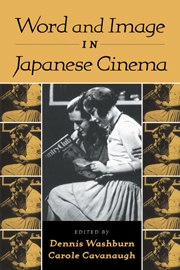Book contents
- Frontmatter
- Contents
- List of Illustrations
- Contributors
- Foreword: Outside Views of the Japanese Film
- Introduction
- PART ONE WORDING THE IMAGE/IMAGING THE WORD
- 1 The Word before the Image: Criticism, the Screenplay, and the Regulation of Meaning in Prewar Japanese Film Culture
- 2 The Cinematic Art of Higuchi Ichiyô's Takekurabe (Comparing Heights, 1895–1896)
- 3 Once More and Gosho's Romanticism in the Early Occupation Period
- 4 The Taunt of the Gods: Reflections on Woman In The Dunes
- 5 Adapting The Makioka Sisters
- 6 In the Show House of Modernity: Exhaustive Listing in Itami Jûzô's Tanpopo
- PART TWO REFLECTIONS OF IDENTITY
- PART THREE OUTSIDE THE FRAME OF CULTURE
- Selected Bibliography of Articles and Books in English
- Index
3 - Once More and Gosho's Romanticism in the Early Occupation Period
Published online by Cambridge University Press: 01 March 2010
- Frontmatter
- Contents
- List of Illustrations
- Contributors
- Foreword: Outside Views of the Japanese Film
- Introduction
- PART ONE WORDING THE IMAGE/IMAGING THE WORD
- 1 The Word before the Image: Criticism, the Screenplay, and the Regulation of Meaning in Prewar Japanese Film Culture
- 2 The Cinematic Art of Higuchi Ichiyô's Takekurabe (Comparing Heights, 1895–1896)
- 3 Once More and Gosho's Romanticism in the Early Occupation Period
- 4 The Taunt of the Gods: Reflections on Woman In The Dunes
- 5 Adapting The Makioka Sisters
- 6 In the Show House of Modernity: Exhaustive Listing in Itami Jûzô's Tanpopo
- PART TWO REFLECTIONS OF IDENTITY
- PART THREE OUTSIDE THE FRAME OF CULTURE
- Selected Bibliography of Articles and Books in English
- Index
Summary
A demobilized soldier in his early thirties stands on a street corner outside a Tokyo museum, waiting for someone. At his feet is a suitcase with the name Nogami Tetsuya on it. His face is tense, anxious. Suddenly, he sees a woman walking across the street, but she neither stops nor looks his way. Moments later he sees another woman, but she too passes by. Deep in thought, he paces back and forth for awhile. Then, from his breast pocket, he takes out a woman's wristwatch. Holding it tenderly, he thinks to himself, “I came back to the designated place. … I wanted to see her once again … but in vain.” As his thoughts continue, the scene dissolves into another. Once again he waits at the same place. However, he is no longer in uniform, and the day, which before was sunny, is now rainy and dreary. “Did she forget her promise?” he wonders. “She said if she were alive, we'd meet again. Is she alive? Couldn't she survive the war?” Her words then come back to him: “Let's meet again,” she says, almost pleadingly. “Remember, every Sunday at 10:00 in the morning.”
Thus begins Ima hitotabino (Once More, 1947), the first film Gosho Heinosuke made after the war, and the first of two films he directed for the Toho Studio. Based on the novel by Takami Jun and told in flashback, Once More is a sweet, unabashedly sentimental love story with political overtones.
- Type
- Chapter
- Information
- Word and Image in Japanese Cinema , pp. 59 - 88Publisher: Cambridge University PressPrint publication year: 2000

